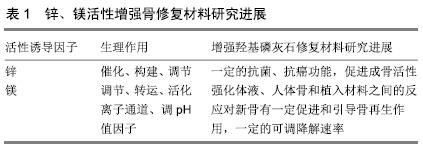[1] ORYAN A, ALIDADI S, BIGHAM-SADEGH A, et al. Comparative study on the role of gelatin, chitosan and their combination as tissue engineered scaffolds on healing and regeneration of critical sized bone defects: an in vivo study.J Mater Sci Mater Med. 2016; 27(10):155.
[2] GARCÍA-GARETA E, COATHUP MJ, BLUNN GW. Osteoinduction of bone grafting materials for bone repair and regeneration. Bone. 2015;81:112-121.
[3] BASHA RY, SANPATH KTS, DOBLE M.Design of bio composite materials for bone tissue regeneration. MaterSci Eng C. 2015;57: 452-463.
[4] LEI Y, XU Z, KE Q, et al.Strontium hydroxyapatite/chitosan nanohybrid scaffolds with enhanced osteoinductivity for bone tissue engineering.Mater Sci Eng C Mater Biol Appl. 2017;72: 134-142.
[5] TERUKINA T, SAITO H, TOMITA Y, et al.Development and effect of a sustainable and controllable simvastatin-releasing device based on PLGA microspheres/carbonate apatite cement composite: In vitro evaluation for use as a drug delivery system from bone-like biomaterial.J Drug Deliv Sci Technol. 2016;37:74-80.
[6] RATNAYAKE JTB, MUCALO M, DIAS GJ.Substituted hydroxyapatites for bone regeneration: A review of current trends.J Biomed Mater Res B Appl Biomater. 2017;105(5): 1285-1299.
[7] 吴兰.人骨与纳米骨修复材料的比较研究[D].成都:四川大学, 2006.
[8] 韩金凤,彭豫东,付莹,等.锌的生理作用及其对仔猪生长性能和免疫力的影响[J].饲料博览,2016,29(4):43-45.
[9] ALIOUI H, BOURAS O, BOLLINGER JC.Toward an efficient antibacterial agent: Zn- and Mg-doped hydroxyapatite nanopowders.J Environ Sci Health A Tox Hazard Subst Environ Eng. 2019;54(4):315-327.
[10] RAJENDRAN A, BALAKRISHNAN S, KULANDAIVELU R, et al. Multi-element substituted hydroxyapatites: synthesis, structural characteristics and evaluation of their bioactivity, cell viability, and antibacterial activity. J Sol-Gel Sci Technol. 2018;86(2):441-458.
[11] 石伟,赵大鹏,尚鹏,等.Mg-4Zn合金表面掺锶羟基磷灰石涂层:物理化学性质及体外细胞响应[J].稀有金属材料与工程, 2018,47(8): 2371-2380.
[12] BOANINI E, GAZZANO M, BIGI A.Ionic substitutions in calcium phosphates synthesized at low temperature.Acta Biomater. 2010;6(6):1882-1894.
[13] KWIECIEŃ M, WINIARSKA-MIECZAN A, MILCZAREK A, et al. Effects of zinc glycine chelate on growth performance, carcass characteristics, bone quality, and mineral content in bone of broiler chicken. Livestock Sci.2016;191:43-50.
[14] HADLEY KB, NEWMAN SM, HUNT JR.Dietary zinc reduces osteoclast resorption activities and increases markers of osteoblast differentiation, matrix maturation, and mineralization in the long bones of growing rats.J Nutr Biochem. 2010;21(4): 297-303.
[15] SHEPHERD DV, KAUPPINEN K, BROOKS RA, et al.An in vitro study into the effect of zinc substituted hydroxyapatite on osteoclast number and activity.J Biomed Mater Res A. 2015; 102(11):4136-4141.
[16] HSU SH, LIN YY, HUANG S, et al.Synthesis of water-dispersible zinc oxide quantum dots with antibacterial activity and low cytotoxicity for cell labeling. Nanotechnology. 2013;24(47): 475102.
[17] GRANDJEAN-LAQUERRIERE A, LAQUERRIERE P, Jallot E, et al. Influence of the zinc concentration of sol-gel derived zinc substituted hydroxyapatite on cytokine production by human monocytes in vitro.Biomaterials.2006;27(17):3195-3200.
[18] JANA TK, JANA SK, KUMAR A, et al.The antibacterial and anticancer properties of zinc oxide coated iron oxide nanotextured composites.Colloids Surf B Biointerfaces. 2019; 177:512-519.
[19] DHIVYA S, SARAVANAN S, SASTRY TP, et al. Nanohydroxyapatite-reinforced chitosan composite hydrogel for bone tissue repair in vitro and in vivo.J Nanobiotechnology. 2015;13(1):40-40.
[20] 孙广飞.锌掺杂羟基磷灰石复合支架制备及抗菌抗炎性能[D].武汉:华中科技大学,2016.
[21] YANG H, QU X, LIN W, et al.In vitro and in vivo studies on zinc-hydroxyapatite composites as novel biodegradable metal matrix composite for orthopedic applications.Acta Biomater. 2018;71:200-214.
[22] GNANESHWAR PV, SUDAKARAN SV, ABISEGAPRIYAN S, et al. Ramification of zinc oxide doped hydroxyapatite biocomposites for the mineralization of osteoblasts.Mater Sci Eng C Mater Biol Appl. 2019;96:337-346.
[23] TER BRAAKE AD, TINNEMANS PT, SHANAHAN CM, et al. Magnesium prevents vascular calcification in vitro by inhibition of hydroxyapatite crystal formation.Sci Rep. 2018;8(1):2069.
[24] SAHMANI S, SABER-SAMANDARI S, KHANDAN A, et al. Influence of MgO nanoparticles on the mechanical properties of coated hydroxyapatite nanocomposite scaffolds produced via space holder technique: Fabrication, characterization and simulation. J Mech Behav Biomed Mater.2019;95:76-88.
[25] ALSHEMARY AZ, AKRAM M, GOH YF, et al.Synthesis, characterization, in vitro bioactivity and antimicrobial activity of magnesium and nickel doped silicate hydroxyapatite.J Ceramic Int.2015;41(9):11886-11898.
[26] CASTIGLIONI S, CAZZANIGA A, ALBISETTI W, et al. Magnesium and osteoporosis: current state of knowledge and future research directions.Nutrients.2013;5(8):3022-3033.
[27] HE LY, ZHANG XM, LIU B, et al.Effect of magnesium ion on human osteoblast activity.Braz J Med Biol Res.2016;49(7).pii: S0100-879X2016000700604.
[28] ANDRÉS NC, SIEBEN JM, BALDINI M, et al.Electroactive Mg2+ Hydroxyapatite Nanostructured Networks against Drug- Resistance Bone Infection Strains.ACS App Mater Interfaces. 2018;10(23):19534-19544.
[29] WETTELAND CL.Magnesium Oxide Based Nanocomposites for Bone Repair.UC Riverside,2017.
[30] 马晓雨,刘永佳,朱邦尚.镁掺杂纳米羟基磷灰石的制备及其在载药方面的应用[J].无机化学学报,2018,34(5):e917-e924.
[31] NYGREN H, BIGDELI N, ILVER L, et al.Mg-corrosion, hydroxyapatite, and bone healing. Biointerphases. 2017;12(2): 02C407.
[32] CRESPI R, MARIANI E, BENASCIUTTI E, et al. Magnesium- enriched hydroxyapatite versus autologous bone in maxillary sinus grafting: combining histomorphometry with osteoblast gene expression profiles ex vivo.J Periodontol. 2017;80(4):586-593.
[33] DENG L, LI D, YANG Z, et al.Repair of the calvarial defect in goat model using magnesium-doped porous hydroxyapatite combined with recombinant human bone morphogenetic protein-2.Biomed Mater Eng. 2017;28(4):361-377.
[34] LANDI E, LOGROSCINO G, PROIETTI L, et al.Biomimetic Mg-substituted hydroxyapatite: from synthesis to in vivo behaviour. J Mater Sci Mater Med.2008;19(1):239-247.
[35] 车鸿泽,车彦海,卢晴,等.PLGA涂层处理的nHA-Mg多孔复合材料对兔颌骨缺损的修复作用[J].吉林大学学报(医学版), 2017, 43(2): 276-280.
[36] SARTORI M, GIAVARESI G, TSCHON M, et al.Long-term in vivo experimental investigations on magnesium doped hydroxyapatite bone substitutes.J Mater Sci Mater Med. 2014;25(6):1495-1504.
[37] 皮国富,王义生,刘宏建,等.羟基磷灰石涂层镁合金材料体内降解及生物相容性研究[J]中华实验外科杂志, 2010,27(8): 1162-1164.
[38] LI H, ZHENG Y, LING Q.Progress of biodegradable metals.Prog Nat Sci Mater Int.2014;24(5):414-422.
[39] BYEON IS, HWANG IJ, CHOE HC, et al.Electrochemically-coated hydroxyapatite films on nanotubular Ti Nb alloys prepared in solutions containing Ca,P,and Zn ions.J Thin Solid Films. 2016; 620:132-138.
[40] SOON LL, ZUHAILAWATI H, SUHAINA I, et al.Prediction of Compressive Strength of Biodegradable Mg–Zn/HA Composite via Response Surface Methodology and Its Biodegradation.J Acta Metallurgica Sinica. 2016;29(5): 464-474.
|



